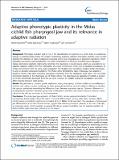Por favor, use este identificador para citar o enlazar a este item:
http://hdl.handle.net/10261/42757COMPARTIR / EXPORTAR:
 SHARE
BASE SHARE
BASE
|
|
| Visualizar otros formatos: MARC | Dublin Core | RDF | ORE | MODS | METS | DIDL | DATACITE | |

| Título: | Adaptive phenotypic plasticity in the Midas cichlid fish pharyngeal jaw and its relevance in adaptive radiation |
Autor: | Muschick, Moritz; Barluenga, Marta CSIC ORCID ; Salzburger, Walter; Meyer, Axel | Fecha de publicación: | 30-abr-2011 | Editor: | BioMed Central | Citación: | BMC Evolutionary Biology. 11(1):116 (2011) | Resumen: | Abstract Background Phenotypic evolution and its role in the diversification of organisms is a central topic in evolutionary biology. A neglected factor during the modern evolutionary synthesis, adaptive phenotypic plasticity, more recently attracted the attention of many evolutionary biologists and is now recognized as an important ingredient in both population persistence and diversification. The traits and directions in which an ancestral source population displays phenotypic plasticity might partly determine the trajectories in morphospace, which are accessible for an adaptive radiation, starting from the colonization of a novel environment. In the case of repeated colonizations of similar environments from the same source population this "flexible stem" hypothesis predicts similar phenotypes to arise in repeated subsequent radiations. The Midas Cichlid (Amphilophus spp.) in Nicaragua has radiated in parallel in several crater-lakes seeded by populations originating from the Nicaraguan Great Lakes. Here, we tested phenotypic plasticity in the pharyngeal jaw of Midas Cichlids. The pharyngeal jaw apparatus of cichlids, a second set of jaws functionally decoupled from the oral ones, is known to mediate ecological specialization and often differs strongly between sister-species. Results We performed a common garden experiment raising three groups of Midas cichlids on food differing in hardness and calcium content. Analyzing the lower pharyngeal jaw-bones we find significant differences between diet groups qualitatively resembling the differences found between specialized species. Observed differences in pharyngeal jaw expression between groups were attributable to the diet's mechanical resistance, whereas surplus calcium in the diet was not found to be of importance. Conclusions The pharyngeal jaw apparatus of Midas Cichlids can be expressed plastically if stimulated mechanically during feeding. Since this trait is commonly differentiated - among other traits - between Midas Cichlid species, its plasticity might be an important factor in Midas Cichlid speciation. The prevalence of pharyngeal jaw differentiation across the Cichlidae further suggests that adaptive phenotypic plasticity in this trait could play an important role in cichlid speciation in general. We discuss several possibilities how the adaptive radiation of Midas Cichlids might have been influenced in this respect. | URI: | http://hdl.handle.net/10261/42757 | Identificadores: | http://dx.doi.org/10.1186/1471-2148-11-116 |
| Aparece en las colecciones: | (MNCN) Artículos |
Ficheros en este ítem:
| Fichero | Descripción | Tamaño | Formato | |
|---|---|---|---|---|
| 1471-2148-11-116.xml | 98,7 kB | XML | Visualizar/Abrir | |
| 1471-2148-11-116.pdf | 464,68 kB | Adobe PDF |  Visualizar/Abrir |
CORE Recommender
Page view(s)
329
checked on 26-abr-2024
Download(s)
529
checked on 26-abr-2024
Google ScholarTM
Check
NOTA: Los ítems de Digital.CSIC están protegidos por copyright, con todos los derechos reservados, a menos que se indique lo contrario.
